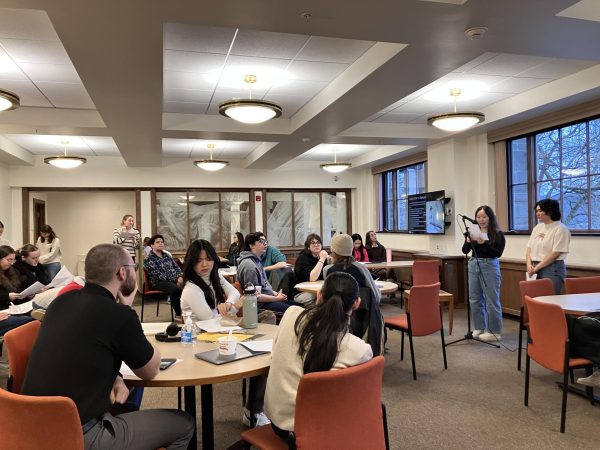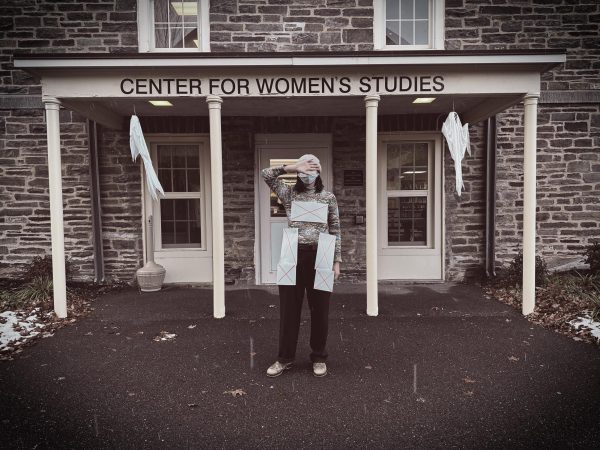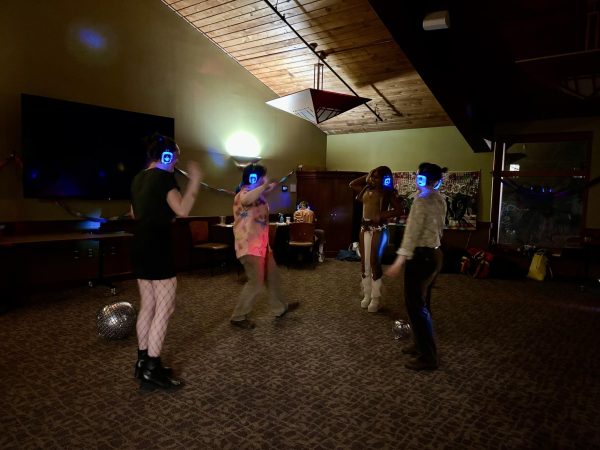Catanese Presents “A Century of Progress / Sleep”
Hybrid media artist Paul Catanese shared exciting insights on his current work-in-progress, “A Century of Progress / Sleep” in the Arts and Humanities Colloquium with Colgate students, faculty, and community members in Golden Auditorium on October 23. Catanese is the Christian A. Johnson Artist-in-Residence for the 2019 spring semester, and his work has been exhibited internationally at notable venues and festivals, including the Whitney Museum of American Art in New York City. Catanese works in a variety of media, including installation, performance, printmaking, video, sculptural objects, handmade paper, artist books, code and projections. Catanese is the Director of Graduate Study and Associate Professor of Art & Art History at Columbia College Chicago.
With a self-proclaimed identity of “hybrid media artist,” Catanese explained that this identity entails creating art in different forms as a source of propulsion to keep himself unsteady; ultimately, it is a way of making his life inconvenient. Thought experiments drive
Catanese’s practice, as he allows his ideas to take precedent and lets materials follow for production. He has a philosophy and theater design background, and his origins in art are as a printmaker. Catanese explained that he is constantly pushing his work and his processes.
The first piece Catanese showed was a finished work titled “Visible from Space,” created in 2016 at the Chicago Cultural Center. In this piece, a large white, remote-controlled blimp glides above iridescent sheets of tin foil and rope, as a fog machine eerily emits a haze over the room. “Visible from Space” was performed in concert with a musical score of blaring classical and baroque trumpet sounds, performed by Chris Kallymer, complemented by light pangs of resonant bells throughout the space. This multi-sensory performance and video piece is part sculpture, part video installation, part film and part musical-performance. Catanese recorded process videos of his construction of the space, original sketches for the piece and shared documentation footage from the perspective of the blimp during the performance.
Catanese said his inspiration stemmed from his curiosity about the concept of what it might mean to make a drawing so large that it could be seen by someone standing on the moon. Catanese posited that for a drawing to be seen from space, it would need to be a line that is at least 60 miles wide; the curiosity, impracticality and improbability of this starting point invoked a response in Catanese to create “Visible from Space.”
Catanese next discussed his contemporary project, “Century of Progress / Sleep.” Catanese began planning this piece by considering the popular notion that “the truth is somewhat suddenly under attack” in current years and positing that this idea is not true. Comfort is elusive, synthetic and complex; ambiguity urgently needs to be inspected, he said. To address this conundrum, Catanese decided to create an opera to explore the relationships between music, emotions and the “feeling” aspects of generating a response.
Though he first tried writing poems, he soon realized that he needed to represent his texts through song to commit to his work. As a cross disciplinary opera, the piece contains themes such as methods of hypnosis, mirage ritual and levitation. According to Catanese, the work “navigates a geometric libretto—a terrain of texts—where inanimate objects, hyperobjects, and hypothetical entities excavate half-truths, mischaracterizations of science, and lawless theories of knowledge.”
At this moment, one-third of his libretto is finished, 36 minutes of musical arrangement have been compiled and a diptych screen of his visual piece is set to engage his audience in a planetarium.
He hopes Colgate students can help him write more of his libretto, assist in orchestrating his arrangement for a five person ensemble and help create a recording of his piece.
“I was really interested in the idea of an opera, but my concept of an opera was thrown off after viewing Catanese’s work. His comments on lawless theories of knowledge made me cope with the idea that my concept of an opera as I knew it was not the idea of all that an opera could be,” sophomore Carina Hayden said.
Catanese is curious about what it means to make a work in which the time-period aspect of it is speculative, and for him, this project won’t be complete until 2034. Artwork should be an engine, full of fractal moments exploding from itself, Catanese said, advising students and artists to “follow your nose; your curiosity will lead you places.”
Catanese will be in residence next February and will perform his piece “A Century of Progress, A Century of Sleep” in early April.
Contact Caylea Barone at [email protected].
Caylea Barone is a senior from LaGrangeville, New York concentrating in environmental studies and art and art history with an emphasis in studio art. She...




